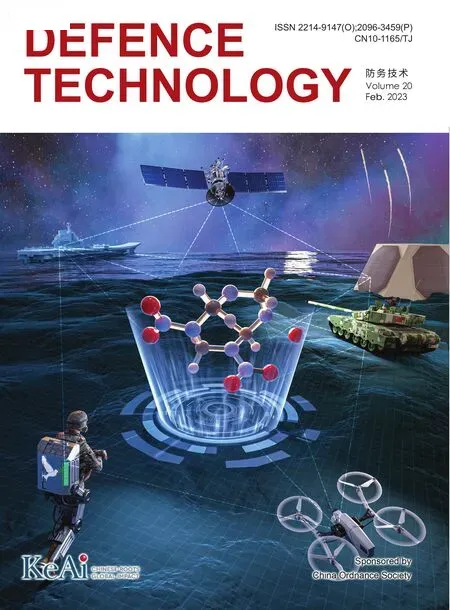Explosion characteristics of aluminum-based activated fuels containing fluorine
Jin-to Xu , Lei Hung , Hi-peng Jing , Tin-jio Zhng , Feng-qi Zho ,Jin-kn Zhng , Wei Go ,*
a State Key Laboratory of Fine Chemicals,Department of Chemical Machinery and Safety Engineering,Dalian University of Technology,Dalian,116024,China
b Beijing Institute of Aerospace Testing Technology, Beijing,100074, China
c Science and Technology on Combustion and Explosion Laboratory, Xi'an Modern Chemistry Research Institute, Xi'an, 710065, China
Keywords:Aluminum-based activated fuels Ignition sensitivity Flame propagation Explosion severity Explosion mechanism
ABSTRACT Measuring the dust explosion characteristics of aluminum-based activated fuels was a prerequisite for developing effective prevention and control measures.In this paper, ignition sensitivity, flame propagation behaviors and explosion severity of aluminum/polytetrafluoroethylene (Al/PTFE) compositions including 2 PT(2.80 wt.%F),4 PT(7.18 wt.%F)and 8 PT(11.90 wt.%F)were studied.When the content of F increased from 2.80 wt.% to 11.90 wt.%, the minimum explosive concentration MEC decreased from 380 g/m3 to 140 g/m3, due to the dual effects of increased internal active aluminum and enhanced reactivity.The average flame propagation velocities increased as the percentage of F increased.The maximum explosion pressure Pm of 500 g/m3 aluminum-based activated fuels increased from 247 kPa to 299 kPa.Scanning electron microscopy demonstrated that with the increase of PTFE content,the reaction was more complete.On this basis, the explosion mechanism of aluminum-based activated fuels was revealed.
1.Introduction
To improve the energy release performance of aluminumcontaining fuels, a coating modification method on aluminum powder to improve its reactivity was developed.Considering the excellent corrosion resistance, heat resistance, low surface energy and good oxidation resistance[1,2],fluoropolymer was widely used for coating aluminum powder.Using fluoropolymer to coat aluminum powder can improve the reactivity of aluminum powder.Moreover,the energy characteristics of fluoropolymer can improve the energy release of the system.The addition of fluoropolymer will lower the ignition temperature of the activated fuel and reduce the agglomeration phenomenon [3,4].In previous studies, it was shown that the energy released by the reaction of Al and F(56.10 kJ/g)was about twice that of the reaction of Al and O(30.98 kJ/g)[5],therefore, fluorine-containing aluminum-based activated fuels became a hot research direction in the field of energetic materials[1,6-10].
Many researchers have carried out a series of studies on the fluorine-containing aluminum-based activated fuels.Yarrington et al.[11]conducted experiments on composite fuels prepared by polytetrafluoroethylene (PTFE) and aluminum powder, and found that the modified aluminum powder had a higher burning rate.The addition of fluoropolymer would lower the ignition temperature of the aluminum-based energetic material and increase its gas production [12,13].Travis et al.[13]investigated the combustion characteristics of solid propellants made of Al/PTFE composite particles after mechanical activation, and demonstrated that the smaller the diameter of the condensed phase product of the propellant,the more gaseous products,and the smaller the two-phase flow loss.Huston et al.[14]examined the flame propagation of mechanically activated Al/PTFE composites under different stoichiometry,and the maximum burning rate was observed when the mass ratio of Al and PTFE was 1:1.Osborne et al.[15]studied the thermal degradation behavior of PTFE and nano-Al dust by thermal analysis and found the pre-ignition reaction which was controlled by the fluorination of the passivation shell of Al particles.
In the preparation process of composite aluminum-based activated fuels,ball milling was the most practical method.The raw materials were continuously impacted, ground, and stirred under the action of the grinding medium to form particles[15-17].In this process, electric sparks and impact sparks were likely to be generated.Once the suspended aluminum dust in the milling devices reached the explosion limits and encountered the ignition spark, serious aluminum dust explosion would occur.However,little research has focused on the explosion characteristics of aluminum-based activated fuels processed by ball milling, such as explosion pressure, flame propagation behaviors and velocities.Moreover, the reaction mechanism was rarely described in the combination of explosive characteristics of Al/PTFE composites in the previous researches.
In this paper, the explosion sensitivity, flame propagation behaviors and explosion severity of aluminum-based activated fuels were studied to understand the effect of PTFE addition on the explosion characteristics.The parameters such as the MEC and explosion overpressure of different types of samples were experimentally determined.The explosion products were analyzed by scanning electron microscope(SEM)and X-ray diffraction(XRD),the explosion mechanism of aluminum-based activated fuels was revealed and the explosion reaction was described in detail.
2.Experimental
2.1.Experimental apparatus
Owing to the fact that the flame propagation behaviors cannot be clearly studied by conducting experiments in 20 L spherical chamber.Consequently, the explosion characteristics test apparatus with an optically accessible window was designed to investigate the flame propagation behaviors of the aluminum-based active fuels.An experimental platform for the explosion characteristics of aluminum-based activated fuels is shown in Fig.1,which consisted of an optically accessible explosion chamber, a powder dispersion system, an ignition system, a pressure test system, a high-speed camera system, a time controller system, and a data acquisition system.
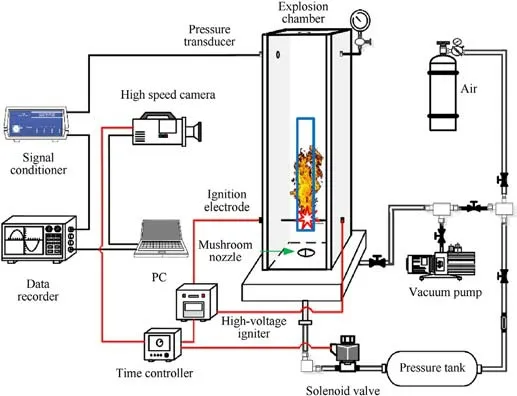
Fig.1. Schematic diagram of experimental apparatus.
The internal dimensions of the cavity of the visual explosive container were 300×70×70 mm3,and the volume was 1.47 L.The material was 316 stainless steel, and the design pressure was 10 MPa.In order to photograph the dynamic evolution of the flame,a quartz glass(150×30×30 mm3)with good optical performance was installed in the front of the cavity.The powder dispersion system included a buffer tank (volume 50 mL), a solenoid valve, a gas pipeline, a mushroom nozzle and other components.The ignition system consisted of a high-voltage transformer with capacity of 15 kV,solid state relays,AC contactors,ignition electrodes and ceramic tubes.A pair of tungsten wire electrodes with a diameter of φ = 0.4 mm were used as ignition electrodes, and the electrode tip spacing was about 4 mm.The duration of electrode discharge was 250 ms.High-speed FASTCAM SA4 camera(1024 × 1024 pixels, 20,000 fps) was used to record the flame propagation behaviors in the experiments.A piezoelectric highprecision dynamic pressure sensor (PCB113B24, range 0-6.89 MPa,accuracy 0.725 mV/kPa)was used to measure the dust explosion overpressure.The triggers of ignition system, powder dispersion system and high-speed camera were all logically controlled by the timing controller.
2.2.Experimental material
It was necessary to characterize the dust samples before conducting explosion experiments on aluminum-based activated fuels.The dust samples used in the experiment were provided by Xi'an Modern Chemistry Research Institute, including spherical Al powder and aluminum-based activated fuels 2 PT, 4 PT and 8 PT.The aluminum-based activated fuels were prepared by ball milling after spherical Al powder of same particle size was added with different proportions of PTFE.The particle size distribution of the sample dust particles were analyzed with the aid of a Malvern Mastersizer 2000, and the microscopic morphology of Al, 2 PT, 4 PT, and 8 PT dust particles was visually obtained by SEM.
The particle size distributions and scanning electron micrographs of dust particles of Al, 2 PT, 4 PT and 8 PT are presented in Fig.2.It can be seen from Fig.2(a) that the Al dust sample was roughly regular and nearly spherical with excellent dispersibility.2 PT, 4 PT and 8 PT samples exhibited a flaky structure, and the oxide layer after modification on the surface was in a stacked layer shape.The Sauter mean diameter,D[2,3], also called the surface mean diameter, corresponded to the diameter of a sphere with equal surface area.The volume-weighted mean diameterD[3,4]was defined in terms of the moment-ratio system, assuming spherical particles of the same volume as the actual particles.Dv(10),Dv(50)andDv(90)indicated that the portion of particles with diameters below this value was 10%, 50% and 90%.It has been indicated by Castellanos et al.[18]thatD[2,3](surface mean diameter) could provide a better description of the averaged aluminum sample size,because that was adequately related to the real potential hazard of aluminum dust.The Sauter mean diametersD[2,3]of 2 PT,4 PT and 8 PT were 23.28 μm,32.09 μm and 41.13 μm respectively.Some other characteristic diameters were presented in Table 1.It can be found that as the content of PTFE increased,the integrity of the stacked flakes on the surface became worse,and the particle size became larger.Owing to the increase of PTFE, the Al particles will be coated or embedded inside, increasing the difficulty of the dust particles being broken during mechanical activation.

Fig.2. Particle size distributions and SEM images of aluminum and aluminum-based activated fuels: (a) Al; (b) 2 PT; (c) 4 PT; (d) 8 PT.

Table 1Particle size distribution statistics of aluminum-based activated fuels.
The obtained element composition and ratio analyzed by energy dispersive spectrometer(EDS)are shown in Table 2.The Al element content in the Al dust sample exceeded 95%,the O element content was about 4%,and there were small number of impurity elements.In addition to Al and O elements in 2 PT,4 PT and 8 PT,the content of F element accounted for 2.80%, 7.18% and 11.90%, respectively.
2.3.Experimental procedure
The specific experimental procedure was as follows.Before ignition, the accurately weighed dust was evenly spread in the hemispherical cup under the mushroom nozzle.The high-pressure buffer tank was filled with 400 kPa air by a high-pressure cylinder.The pressure in the explosion chamber was pumped to the predetermined vacuum degree, so that the pressure in the chamberreached atmospheric pressure after the solenoid valve was triggered.After the injection of sample dust,which lasted 350 ms,the suspended dust cloud was ignited by a 15 kV high-voltage transformer.The ignition delay time was 450 ms.

Table 2Elemental composition and content of aluminum and aluminum-based activated fuels.
3.Results and discussion
3.1.Effects of PTFE content on ignition sensitivity of aluminumbased activated fuels
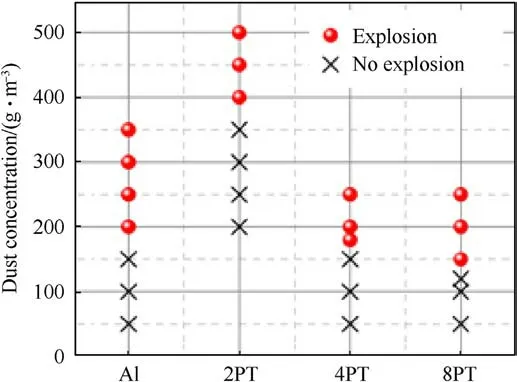
Fig.3. MEC measurements of aluminum and aluminum-based activated fuels.
Fig.3 shows the minimum explosive concentration MEC of different types of samples with the ignition energy of 1.1 J.The experiments were repeated 3-5 times for ensuring the accuracy of the experimental results.It can be seen that Al dust was not ignited at 150 g/m3and ignited at 200 g/m3.The MEC of Al dust can be obtained between 150 g/m3and 200 g/m3, which can reflect the ignition sensitivity of dust.As shown in Fig.3,it was found that the MEC of the sheet-shaped 2 PT with PTFE added was significantly higher than that of spherical Al dust, and the MEC gradually decreased with the increasing of the proportion of PTFE.The MEC of the presented samples can be summarized as follows:8 PT <4 PT <Al <2 PT.
During the preparation process of 2 PT, 4 PT and 8 PT by ball milling, in order to ensure that the dust in the ball mill was prevented from being ignited, the air in the ball mill was generally replaced by inert gas (nitrogen or argon).After the mechanical activation was completed, at room temperature, fill the ball mill with oxygen below the safety limit of oxygen content to passivate the ball milled aluminum-based activated fuels [14,17].The oxidation process of aluminum surface included the adsorption and separation of oxygen by aluminum,and the migration of aluminum ions, oxygen ions and electrons on the surface of aluminum particles,which made the surface of aluminum particles form a layer of amorphous Al2O3film [19].Compared with Al dust, the surface of the multi-layer composite structure of the aluminum-based activated fuel was not completely covered by the oxide layer.During the high-energy ball milling process, part of the PTFE was embedded in the surface of the aluminum powder, and some formed a flake-like coating on the surface, as shown in Fig.2 [14].Because the addition of PTFE in 2 PT was less compared with that of 4 PT and 8 PT,the aluminum particles were not completely coated after mechanical activation,which caused the active aluminum on the surface to be further oxidized during the passivation process,resulting in a further reduction in the mass fraction of active aluminum.More capacitive impedance was produced by the alumina, which could reduce ignition sensitivity [20].On the contrary, for 4 PT and 8 PT with more PTFE added, more active aluminum components were retained.Consequently, the increase of the MEC between Al and 2 PT can be attributed to the reduction of active aluminum in the particles.With the increase of F content,2 PT,4 PT and 8 PT had stronger reactivity(8 PT>4 PT>2 PT)and the MEC decreased (8 PT <4 PT <2 PT) [21].One reasonable explanation for this phenomenon could be that the change of MEC was more sensitive to the content of F element compared with the content of active aluminum.
3.2.Effects of PTFE content on flame propagation behaviors of aluminum-based activated fuels
For a concentration of 500 g/m3, the flame propagation behaviors of spherical Al dust and flake composite dust 2 PT,4 PT and 8 PT are shown in Fig.4.In order to observe the dust explosion changes of aluminum-based activated fuels, the images presented the explosion process of pure Al dust were given as a comparison.The irregular flame propagation occurred in the early stage(t= 25-40 ms), resulting from the uneven distribution of Al particles around the ignition electrodes [22].Moreover, the smooth and continuous flame fronts were presented in the flames of Al(t= 50-80 ms) and 8 PT, which were consistent with the theory that micron-sized aluminum particles generally undergo the homogeneous gas phase reaction[23].However,in the images of 2 PT and 4 PT,the flame fronts were discrete,and the white light areas in the flame were scattered randomly in the combustion reaction zone.Furthermore, it can be seen from Fig.4(b) that during the explosion process of 2 PT, a large amount of unignited dust was adsorbed on the window, which was caused by the electrostatic force between the window and small particles[24].It showed that with the increase of PTFE content,the flame front was discrete and irregular at first,until the content of F reaches 11.90 wt.%,the flame shape was basically the same as that of pure aluminum.
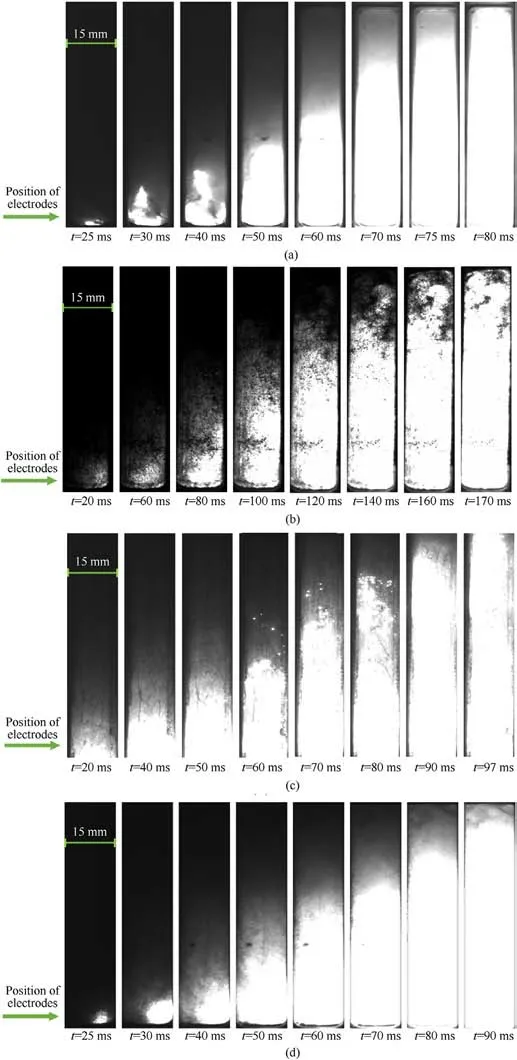
Fig.4. Flame propagation behaviors of aluminum and aluminum-based activated fuels at the concentration of 500 g/m3: (a) Al; (b) 2 PT; (c) 4 PT; (d) 8 PT.
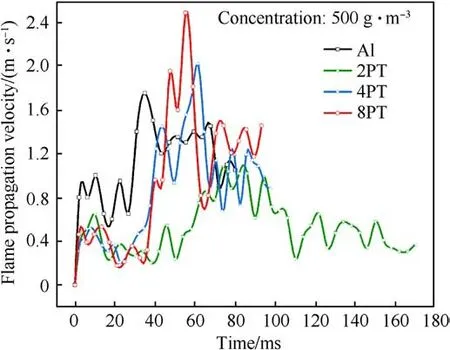
Fig.5. Flame propagation velocities of aluminum and aluminum-based activated fuels.
Fig.5 shows the flame propagation velocities of Al and aluminum-based activated fuels.When the concentration was 500 g/m3,the average flame propagation velocities of Al,2 PT,4 PT and 8 PT were 1.074,0.513,0.856 and 0.938 m/s,respectively.With the increase of PTFE content, the flame propagation velocities showed a trend of first decreasing and then increasing.In addition,the largest fluctuation range was presented in the flame propagation velocity of 8 PT, and the maximum could reach 2.489 m/s,which might be attributed to more heat release and more gas product caused by the reaction between F and Al2O3[9,13].Whereas, the flame propagation velocity of 2 PT with 2.80 wt% F was lower than Al, indicating that the energy density of the fuels was affect by the passivation operation in the ball milling process.
3.3.Effects of PTFE content on explosion severity of aluminumbased activated fuels
Explosion pressure-time curves of 2 PT,4 PT and 8 PT are shown in Fig.6.In order to make the explosion chamber reached atmospheric pressure after the powder dispersion system was triggered.Therefore, the pressure-time curves began to develop from the absolute pressure which is about 50 kPa in the explosion chamber before powder spraying.It can be seen that the maximum explosion pressurePmof 2 PT, 4 PT and 8 PT within the concentration range of 400-500 g/m3had very small changes.Because the aluminum-based activated fuels in the chamber of the 1.47 L experimental device exploded at a constant volume.When the concentration was 400-500 g/m3, the explosion reactions of the aluminum-based activated fuels were complete and the maximum explosion pressures were obtained.
According to the explosion pressure-time curves of different concentrations of 2 PT,4 PT and 8 PT,the parameters such as thePm,the maximum pressure rise rate(dP/dt)mand the explosion indexKstwere calculated[24].As shown in Fig.7,it can be obtained that as the dust concentration increased from 250 g/m3to 500 g/m3,thePmof the three samples showed a gradually increasing trend, but the (dP/dt)mandKstshowed a trend of first increasing and then decreasing.As the content of PTFE increased, the influence of concentration on thePmof 8 PT was greater than 4 PT.ThePmof 4 PT was 215 kPa at 250 g/m3, and it was 295 kPa at 500 g/m3.However, thePmof 8 PT was 130 kPa at 250 g/m3, and it was 299 kPa when the concentration increased to 500 g/m3.

Fig.6. Explosion pressure-time curves of (a) 2 PT, (b) 4 PT and (c) 8 PT.

Fig.7. Explosive characteristic parameters of 2 PT, 4 PT and 8 PT dust.

Fig.8. The relationship of Pm and concentration of aluminum and aluminum-based reactive fuels.
When the oxygen concentration was sufficient, the explosion reaction of the aluminum-based activated fuels was complete.In this case,as the concentrations of 2 PT,4 PT and 8 PT increased,thePmand the (dP/dt)mgradually increased.When the concentration was near the optimal explosive concentration,that was,the ratio of the chemical reaction between the sample dust and oxygen was close to the stoichiometric concentration,the reaction was the most complete at this time.However,when the concentration continued to increase, the oxygen content was insufficient, which will cause incomplete combustion of the sample dust, and the dust particles that were not involved in the reaction will absorb the heat generated by the explosion through heat conduction and thermal radiation [25].
Fig.8 summarizes the relationship betweenPmand concentration of aluminum and aluminum-based activated fuels.For different types of aluminum-based activated fuels, it can be found that thePmwas positively correlated with the dust concentration.At the concentrations of 400 g/m3and 500 g/m3, the aluminumbased activated fuels 2 PT, 4 PT and 8 PT added with PTFE produced higher maximum explosion pressures, because as the content of F increased, the energy release characteristics of the fuels were improved, which will be discussed below.ThePmincreased between 8 PT and 4 PT at the concentrations of 250 g/m3and 350 g/m3as shown in Fig.8.The surprising phenomenon could be explained by the reason:the particle size of 8 PT was about 10 μm larger than that of 4 PT and the particle size played a dominant role rather than the content of F.
3.4.Explosion products analysis
In order to reveal the explosion mechanism of aluminum-based activated fuels,SEM was used to observe the explosion products of different types of samples which exploded at 500 g/m3.The SEM images are shown in Fig.9.These residual particles formed on samples surface were nearly spherical and basically nano-scale,indicating that these particles were formed after a gas phase reaction [26,27].
The 2 PT dust explosion products are shown in Fig.9(a).It can be seen that there were many 2 PT dust particles which had not reacted completely.Most of the nano-scale alumina particles were attached to the surface of the unburnt particles to form fuzzy covering.It indicated that when the concentration was 500 g/m3,the fuel was sufficient but the oxidant concentration was low,resulting in incomplete combustion of the activated fuel.Fig.9(b)shows the morphological characteristics of the solid product after the 4 PT dust explosion.There were many irregular lumpy residues with a particle size of about 20 μm, which were the particles that had not reacted completely.The observation of a cracked spherical oxide shell indicated that the melt-dispersion mechanism occurred during the reaction [5,20,21,28,29].
The morphology of 8 PT explosion products is shown in Fig.9(c).It can be found that the reaction of 8 PT was very sufficient.There were only a few unreacted samples in the scanning electron microscope field of view.The oxidation products were more regular,and the particles were basically spherical.The particles were uniformly dispersed,indicating that the addition of PTFE improved the degree of reaction of the aluminum-based activated fuels.From the results of EDS,it can be found that the product still contains part of the F element, which was the unreacted part of the PTFE.
From the results of EDS in Table 3,with the increase of PTFE,the mass fraction of Al in 2 PT decreased from 82.59% to 58.21% after the reaction, while the mass fraction of Al in 8 PT decreased from 78.33%to 31.02%.At the same time the mass fraction of O increased significantly.As the ratio of O:Al gradually increased, it can be obtained that the reaction of 8 PT was very complete, which was consistent with the conclusion obtained from the scanning electron microscope image.No F element was detected in the product,because most of the fluoropolymer could be cracked and gasified during the explosion reaction.Moreover, aluminum fluorides and oxyfluorides with the relatively high vapor pressure volatilize more readily than aluminum oxides [9].
To further study the change of the crystal forms of the particles after the explosion and reveal the explosion reaction mechanism,the explosion residue was analyzed through characterization methods.The XRD diffraction peaks of the product after the explosion only had A1 and two crystal forms of Al2O3.Since the amorphous alumina cannot be detected by XRD, there was no diffraction peak.It can be found that the explosion products of 2 PT,4 PT and 8 PT all contain α-Al2O3and θ-Al2O3Usually amorphous alumina will begin to form γ-Al2O3when the temperature was above 400°C [30].Literatures [31-33]pointed out that γ-Al2O3began to undergo phase change after 800°C,and transfer to θ-Al2O3with similar fcc crystal structures.As the temperature continued to rise,it will all be transformed into stable α-Al2O3.In Fig.10, there were only θ-Al2O3and α-Al2O3in the products after the explosion, indicating that due to the rapid increase of temperature during the explosion, all γ-Al2O3polymorph was transformed, and only part of θ-Al2O3was transformed into α-Al2O3.This was due to the high temperature in the explosion process, which led to the sublimation of fluorine-containing products and aluminum fluorides [13,33].

Fig.9. SEM images of (a) 2 PT, (b) 4 PT and (c) 8 PT explosion products.

Table 3Elemental composition and content of explosion products of aluminum-based reactive fuels.
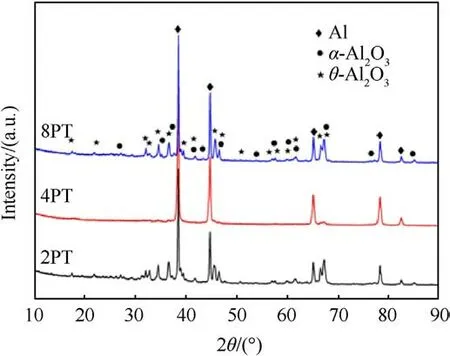
Fig.10. XRD curves of 2 PT, 4 PT and 8 PT explosion products.
The explosion mechanism of aluminum-based activated fuels is illustrated in Fig.11.Typically, for pure micron aluminum powder,the oxidation process was divided into four stages[22].In the first stage, the particle was heated to the melting temperature of the aluminum core.Energy and mass transferred between gas and particle surface, diffusion of mass and energy inside the particle,and polymorphic phase transformations in the oxide layer were key processes of concern.In the second stage,melting of the aluminum core caused volume dilatation and the oxide layer fractured for the expansion stress and the molten aluminum flowed out through the cracks [28,29].In the third stage, polymorphic phase transformations resulted in the formation of a crystalline oxide layer.Melting of the oxide layer resulted in particle ignition.In the fourth stage, the large micron-sized particle burned through gasphase or surface reactions,depending on the oxidizer and pressure.
But for the aluminum-based activated fuels added with PTFE,the explosion mechanism of aluminum-based activated fuels is illustrated in Fig.11.Part of the surface of the flaky aluminum-based activated fuels after mechanical activation was covered or inlaid with PTFE.The uncoated surface also had an amorphous oxide layer.First, when the temperature exceeded 350°C, reactive fluorocarbon fragments were formed from the unstable PTFE, such as difluorocarbene radicals (CF2) and tetrafluoroethylene (C2F4)[33-35].As shown in Fig.11(b), the fluorination occurred at octahedral sites of Al2O3lattices and released carbonyl compounds and AlF3[35].Osborne et al.[15]suggested that the reaction which was caused by fluorine ions from the PTFE interacting with Al2O3to form the catalyst aluminum (III) fluoride (AlF3) in the unstable βphase was called the pre-ignition reaction(PIR).As the temperature rises rapidly, the oxide layer on the surface was destroyed by the PIR and the molten aluminum flowed out.Consequently,compared with pure micron aluminum powder, the reaction of aluminumbased active fuels was accompanied by more heat release and accelerated.Then the reaction 4Al+ 3(-C2F4-)n→4AlF3(g)+ 6C,between PTFE and Al0was further activated [36].The Al droplet evaporated and gasified rapidly at high temperature, and a gas phase diffusion combustion reaction occurred.Owing to that the generated AlF3had a boiling point of 1275°C [9], it was easier to sublime than refractory Al2O3during the reaction [32,33,37].Accordingly, the formation of AlF3or other fluorine-containing products were not detected in the diffraction peaks.A large amount of gas generated during the reaction will reduce the generation of condensed phase products,thereby avoiding or reducing the two-phase loss caused by the formation of condensed metal oxides.Therefore, the degree of explosion reaction was improved and the explosive severity was further enhanced.
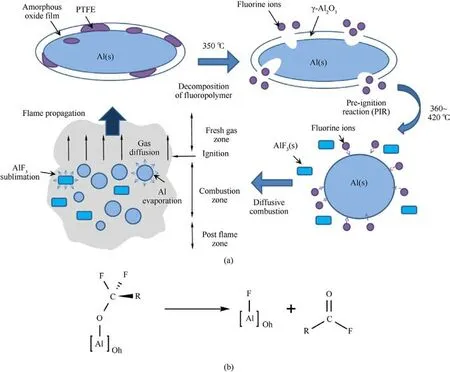
Fig.11. Explosion mechanism of aluminum-based activated fuels: (a) Schematic diagram of explosion reaction mechanism; (b) The fluorination at the octahedral (Oh) site in the alumina lattice.
4.Conclusion
This study conducted experimental and theoretical studies on the ignition sensitivity,flame propagation behaviors and explosion severity of aluminum-based activated fuels dust with different PTFE contents.The results can be summarized as follows:
(1) The order of the MEC of the four samples was as follows:8 PT <4 PT <Al <2 PT.The MEC increased first and then decreased with the increase of F content.This change trend of MEC was influenced by the dual effects of the increase of alumina caused by passivation operation and the increase of F content.
(2) As the F content increased, the flame front of aluminumbased activated fuels changed from discrete and irregular to continuous and smooth.In addition, the flame propagation velocity first decreased and then increased.ThePmof aluminum-based activated fuels was positively correlated with the dust concentration, the increases of the (dP/dt)mand theKstwere limited by the oxidant concentration.
(3) Through the analysis of explosive products,aluminum-based activated fuels will react more fully with the increase of F content,and the dispersibility of the products will be better.According to the reaction mechanism, AlF3generated in the PIR reaction was easy to sublimate, and thus the surface oxide layer was destroyed.Consequently, the addition of PTFE as a fluorinated additive can accelerate the oxidation process, release more heat, produce more gaseous products and avoid or reduce the two-phase loss caused by the production of condensed phases.
The findings of this study can be practically applied in the following two aspects.First,the results suggested that the addition of fluoropolymer can control the overall reactivity of aluminumbased activated fuels.Second, the findings provided theoretical support for essentially constructing safety measures to prevent or control the explosion of aluminum-based activated fuels.Because of the practical limitation, the temperature of aluminum-based activated fuels dust clouds could not be measured.However, this parameter will be investigated in our future research to obtain a more comprehensive understanding of aluminum-based activated fuels dust clouds.
Declaration of competing interest
The authors declare that they have no known competing financial interests or personal relationships that could have appeared to influence the work reported in this paper.
Acknowledgments
The work is financially supported by National Natural Science Foundation of China (No.51922025 and No.51874066), China Postdoctoral Science Foundation (No.2020M670759), and the Fundamental Research Funds for the Central Universities (No.DUT20GJ201).
- Defence Technology的其它文章
- A comparative single-pulse shock tube experiment and kinetic modeling study on pyrolysis of cyclohexane, methylcyclohexane and ethylcyclohexane
- 2D metal-organic frameworks endow ammonium perchlorate with enhanced thermal effect
- Thermal decomposition effect of MgCo2O4 nanosheets on ammonium perchlorate-based energetic molecular perovskites
- Mechanical behavior of entangled metallic wire materialspolyurethane interpenetrating composites
- Modification of SDOF model for reinforced concrete beams under close-in explosion
- Air combat target maneuver trajectory prediction based on robust regularized Volterra series and adaptive ensemble online transfer learning

